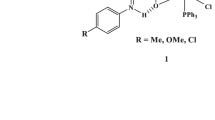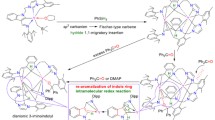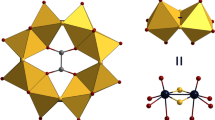Abstract
A lantern-type dinuclear complex cis-[Rh2(4-Me-pf)2(O2CCF3)2] (1) (4-Me-pf− = N,N′-di-p-tolylformamidinate anion) was reacted with an excess of pivalic acid in an aqueous NaOH solution with CHCl3/MeOH (1:3 vol./vol.) at room temperature for 24 h with stirring to give cis-[Rh2(4-Me-pf)2(O2CCMe3)2] (2). A single crystal obtained by recrystallization of 1 from an acetonitrile solution was employed for X-ray crystal structure analysis. The analysis showed that the obtained complex was a cis-[Rh2(4-Me-pf)2(O2CCMe3)2(MeCN)2] (2(MeCN)2) with a lantern-type dinuclear structure and a cis-(2:2) arrangement of the two formamidinato and two carboxylato ligands around the dirhodium(II) core, similar to the previously reported crystal structures for 1(H2O)2·0.5C6H6 and 1(MeCN)2. Complex 2 showed absorption bands at 613, 506, 435, and 344 nm in MeCN, while complex 1 showed the bands at 516, 460, and 326 nm in MeCN. All the bands observed for 1 and 2 were reasonably assigned using time-dependent density functional theory calculation. Moreover, it was confirmed that the electron-donating t-butyl groups on the carboxylato bridges of 2 give rise to negative shifts in the redox potentials (E 1/2 = 0.32 and 1.22 V (vs. SCE) in CH2Cl2) for Rh II,II2 /Rh II,III2 and Rh II,III2 /Rh III,III2 processes relative to those of 1 (E 1/2 = 0.71 and 1.47 V (vs. SCE) in CH2Cl2) that has electron-withdrawing fluorine groups on the carboxylate bridges.







Similar content being viewed by others
References
Bear JL, Yao CL, Lifsey RS, Korp JD, Kadish KM (1991) Electrochemical, spectroscopic, and structural characterization of rhodium complexes Rh2(dpf)4, Rh2(dpf)4(CH3CN), and [Rh2(dpf)4(CH3CN)]ClO4, where dpf = N, N′-diphenylformamidinate(1-). Inorg Chem 30:336–340. doi:10.1021/ic00002a036
Catalan KV, Hess JS, Maloney MM, Mindiola DJ, Ward DL, Dunbar KR (1999) Reactions of DNA purines with dirhodium formamidinate compounds that display antitumor behavior. Inorg Chem 38:3904–3913. doi:10.1021/ic990194n
Cotton FA, Felthouse TR (1980) Structural studies of three tetrakis(carboxylato)dirhodium(II) adducts in which carboxylate groups and axial ligands are varied. Inorg Chem 19:323–328. doi:10.1021/ic50204a010
Cotton FA, Kim Y (1994) Three Rh2(O2CCF3)4L2 compounds, with L=H2O, tetrahydrofuran and acetonitrile. Eur J Solid State Inorg Chem 31:525–534
Cotton FA, Dikarev EV, Feng XJ (1995) Unligated dirhodium tetra(trifluoroacetate): preparation, crystal-structure and electronic-structure. Inorg Chim Acta 237:19–26. doi:10.1016/0020-1693(95)04662-S
Cotton FA, Murillo CA, Walton RA (2005) Multiple bonds between metal atoms, 3rd edn. Springer, New York
Fuma Y, Ebihara M, Kutsumizu S, Kawamura T (2004) A diamondoid network of tetrakis(acetamidato)dirhodium in mixed oxidation states linked by μ4-iodide having a 105 enhancement of its electrical conductivity by water molecules of hydration. J Am Chem Soc 126:12238–12239. doi:10.1021/ja047421r
Fuma Y, Miyashita O, Kawamura T, Ebihara M (2012) Change of electrical conductivities between hydrated and dehydrated samples of honeycomb sheet structures with mixed oxidation state paddlewheel dirhodium complexes and halide ions. Dalton Trans 41:8242–8251. doi:10.1039/c2dt11609j
Handa M, Mikuriya M, Sato Y, Kotera T, Nukada R, Yoshioka D, Kasuga K (1996) Chain compounds of rhodium(II) trifluoroacetate linked by p-quinone [Rh2(O2CCF3)4(p-Q)]n, p-Q = 1,4-benzoquinone, 1,4-naphthoquinone, and 2,3-dimethyl-1,4-benzoquinone. Bull Chem Soc Jpn 69:3483–3488. doi:10.1246/bcsj.69.3483
Handa M, Nakao T, Mikuriya M, Kotera T, Nukada R, Kasuga K (1998) Chain Complexes of rhodium(II) pivalate dimer formed by ligation of C=C double bond and carbonyl oxygen of p-quinone [{Rh2(O2CCMe3)4(p-Q)2}{Rh2(O2CCMe3)4}] n , p-Q = 1,4-benzoquinone and 1,4-naphthoquinone. Inorg Chem 37:149–152. doi:10.1021/ic970246d
Handa M, Watanabe M, Yoshioka D, Kawabata S, Nukada R, Mikuriya M, Azuma H, Kasuga K (1999) Adduct polymers and dimers of rhodium(II) pivalate with pyrazine, 4,4′-bipyridine, 1,4-diazabicyclo[2.2.2]octane, triethylamine, and pyridine. Bull Chem Soc Jpn 72:2681–2686. doi:10.1246/bcsj.72.2681
Handa M, Yasuda M, Muraki Y, Yoshioka D, Mikuriya M, Kasuga K (2003) Polymer and “trimer-of-dimers” complexes derived from [Rh2(form)4] (form- = N, N′-di-p-tolylformamidinate anion) and 1,4-diisocyanobenzene. Chem Lett 32:946–947. doi:10.1246/cl.2003.946
Handa M, Ikeue T, Sanaka A, Nakai T, Tanaka H, Yoshioka D, Mikuriya M (2011a) Assembled complexes of lantern-type rhodium(II) dimers with formamidinato ligands. In: Melnik M, Segla P, Tatarko M (eds) New trends in coordination, bioinorganic and applied inorganic chemistry. Slovak University of Technology Press, Bratislava, pp 133–139
Handa M, Yasuda M, Yoshioka D, Ikeue T, Mikuriya M (2011b) Crystal structure of rhodium(II) formamidinate dimer with an axial acetonitrile molecule. X-ray Struct Anal Online 27:15–16. doi:10.2116/xraystruct.27.15
Handa M, Sanaka A, Sugikawa Y, Ikeue T, Tanaka H, Yoshioka D, Mikuriya M (2011c) Polymer complex of rhodium(II) formamidinate dimer linked by 1,4- diisocyanobenzene with toluene as solvent of crystallization. X-ray Struct Anal Online 27:73–74. doi:10.2116/xraystruct.27.73
Handa M, Inoue R, Inoue A, Nakai T, Ikeue T, Yoshioka D, Mikuriya M (2012) Synthesis and crystal structure of a rhodium(II) formamidinate dimer with axial water and methanol molecules. X-ray Struct Anal Online 28:53–54. doi:10.2116/xraystruct.28.53
Handa M, Takahashi K, Inoue A, Ikeue T, Yoshioka D, Mikuriya M (2015) Crystal structure of a lantern-type dirhodium(II) complex with a cis-(2:2) arrangement of two formamidinato and two trifluoroacetato bridges. X-ray Struct Anal Online 31:31–32. doi:10.2116/xraystruct.31.31
Johnson SA, Hunt HR, Neumann HM (1963) Preparation and properties of anhydrous rhodium(II) acetate and some adducts thereof. Inorg Chem 2:960–962. doi:10.1021/ic50009a020
Kataoka Y, Kitagawa Y, Saito T, Nakanishi Y, Sato K, Miyazaki Y, Kawakami T, Okumura M, Mori W, Yamaguchi K (2011) Theoretical study of absorption spectrum of dirhodium tetracarboxylate complex [Rh2(CH3COO)4(H2O)2] in aqueous solution revisited. Supramol Chem 23:329–336. doi:10.1080/10610278.2010.534553
Mayer U (1976) Solvent effects on ion-pair equillibria. Coord Chem Rev 21:159–179. doi:10.1016/S0010-8545(00)80446-4
Mikuriya M, Higashiguchi T, Sakai T, Yoshioka D, Handa M (2003) Chain compounds of rhodium(II) benzoate bridged by N, N′-didentate ligands. In: Melnik N, Sirota A (eds) Progress in coordination and bioinorganic chemistry. Slovak University of Technology Press, Bratislava, pp 213–218
Mikuriya M, Yoshioka D, Handa M (2006) Magnetic interactions in one-, two-, and three-dimensional assemblies of dinuclear ruthenium carboxylates. Coord Chem Rev 250:2194–2211. doi:10.1016/j.ccr.2006.01.011
Mikuriya M, Yamamoto J, Yoshioka D, Tanaka H, Handa M (2011) Synthesis, crystal structures, and adsorption properties of chain complexes of rhodium(II) pivalate with N, N′-bidentate ligands. In: Melnik M, Segla P, Tatarko M (eds) New trends in coordination, bioinorganic and applied inorganic chemistry. Slovak University of Technology Press, Bratislava, pp 311–319
Mikuriya M, Yamamoto J, Ouchi K, Yoshioka D, Tanaka H, Handa M (2013a) Synthesis, Crystal structure, and N2-adsorption property of a chain complex of rhodium(II) acetate and 1,4-diazabicyclo[2.2.2]octane. X-ray Struct Anal Online 29:7–8. doi:10.2116/xraystruct.29.7
Mikuriya M, Ouchi K, Nakanishi Y, Yoshioka D, Tanaka H, Handa M (2013b) Synthesis, crystal structure, and N2-adsorption property of a chain complex of rhodium(II) benzoate and piperazine. X-ray Struct Anal Online 29:21–22. doi:10.2116/xraystruct.29.21
Mikuriya M, Yamamoto J, Ouchi K, Takada S, Yoshioka D, Tanaka H, Handa M (2013c) Synthesis and crystal structure of a chain complex of rhodium(II) acetate and 1,2-bis(4-pyridyl)ethane having an N2-adsorption property. X-ray Struct Anal Online 29:29–30. doi:10.2116/xraystruct.29.29
Mikuriya M, Yamamoto J, Ouchi K, Yoshioka D, Tanaka H, Handa M (2013d) Synthesis and crystal structure of a chain complex of rhodium(II) benzoate and 1,4-diazabicyclo[2.2.2]octane having an N2-adsorption property. X-ray Struct Anal Online 29:45–46. doi:10.2116/xraystruct.29.45
Mori W, Takamizawa S, Kato CN, Ohmura T, Sato T (2004) Molecular-level design of efficient microporous materials containing metal carboxylates: inclusion complex formation with organic polymer, gas-occlusion properties, and catalytic activities for hydrogenation of olefins. Microporous Mesoporous Mater 73:31–46. doi:10.1016/j.micromeso.2004.02.019
Piraino P, Tresoldi G, Faraone F (1982) Synthesis and reactivity of formamidinato rhodium(I) complexes. J Organomet Chem 224:305–312. doi:10.1016/S0022-328X(00)85843-X
Piraino P, Bruno G, Tresoldi G, Schiavo SL, Zanello P (1987a) Chemical oxidation of binuclear rhodium(I) complexes with silver salts. Synthesis, X-ray crystal structure, and electrochemical properties of the Rh2 4+ mixed-ligand complex Rh2(Form)2(O2CCF3)2(H2O)2·0.5C6H6 (Form = N, N′-di-p-tolylformamidinate anion). Inorg Chem 26:91–96. doi:10.1021/ic00248a019
Piraino P, Bruno G, Schiavo SL, Laschi F, Zanello P (1987b) Synthesis, X-ray crystal structure, and electrochemical properties of the Rh4+ complex Rh2(form)4 (form = N, N′-di-p-tolylformamidinate anion). Inorg Chem 26:2205–2211. doi:10.1021/ic00261a009
Ren T (1998) Substituent effects in dinuclear paddlewheel compounds: electrochemical and spectroscopic investigations. Coord Chem Rev 175:43–58. doi:10.1016/S0010-8545(98)00202-1
Ren T, Lin C, Valente EJ, Zubkowski JD (2000) The influence of remote substituent in tetrakis(μ-N, N′-diarylformamidinato)-dirhodium(II) compounds. Part 7. Linear free energy relationships in dinuclear compounds. Inorg Chim Acta 297:283–290. doi:10.1016/S0020-1693(99)00317-5
Roberts RM (1949) The reaction of diarylformamidines with ethyl malonate. J Org Chem 14:277–284. doi:10.1021/jo01154a013
Takamizawa S, Nakata E, Yokoyama H, Mochizuki K, Mori W (2003) Carbon dioxide inclusion phases of a transformable 1D coordination polymer host [Rh2(O2CPh)4(pyz)] n . Angew Chem Int Ed 42:4331–4334. doi:10.1002/anie.200351368
Vos TE, Liao Y, Shum WW, Her JH, Stephens PW, Reiff WM, Miller JS (2004) Diruthenium tetraacetate monocation, [RuII/III 2(O2CMe)4]+, building blocks for 3-D molecule-based magnets. J Am Chem Soc 126:11630–11639. doi:10.1021/ja048135i
Yoshioka D, Mikuriya M, Handa M (2002) Molecular-assembled complexes of mixed-valent ruthenium dimer with hexacyanoferrate(III) and hexacyanocobaltate(III) ions. Chem Lett 31:1044–1045. doi:10.1246/cl.2002.1044
Acknowledgements
This work has been supported by a Grant-in-Aid for Scientific Research (Nos. 26410080, 15K17897, 15H00877, 16K05722) from the Ministry of Education, Culture, Sports and Technology (MEXT), Japan. The authors are grateful to Dr. Michiko Egawa (Shimane University) for her measurements of elemental analysis.
Author information
Authors and Affiliations
Corresponding author
Electronic supplementary material
Below is the link to the electronic supplementary material.
11696_2017_244_MOESM2_ESM.pdf
Crystallographic data for the structure of complex 2(MeCN)2 reported in this paper have been deposited with the Cambridge Crystallographic Data Centre, CCDC no. 1537380. Copies of the information may be obtained free of charge from: The Director, CCDC, 12 Union Road, Cambridge, CB2 1EZ, UK (fax: +44-1223-336033; e-mail: deposit@ccdc.cam.ac.uk or via http://www.ccdc.cam.ac.uk/conts/retrieving.html (PDF 4316 kb)
Rights and permissions
About this article
Cite this article
Handa, M., Nishiura, S., Masuda, T. et al. Synthesis, structure, and properties of a lantern-type dinuclear rhodium(II) complex cis-[Rh2(4-Me-pf)2(O2CCMe3)2], 4-Me-pf− = N,N′-di-p-tolylformamidinate anion. Chem. Pap. 72, 841–851 (2018). https://doi.org/10.1007/s11696-017-0244-2
Received:
Accepted:
Published:
Issue Date:
DOI: https://doi.org/10.1007/s11696-017-0244-2




